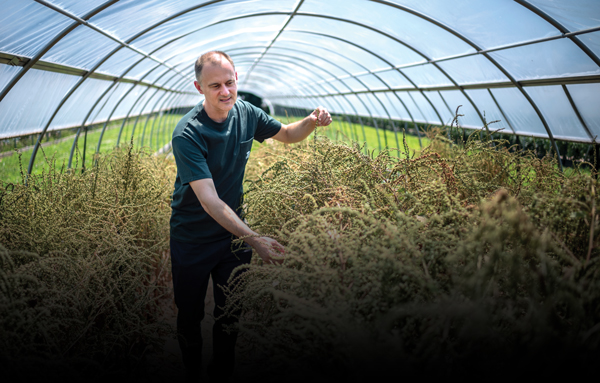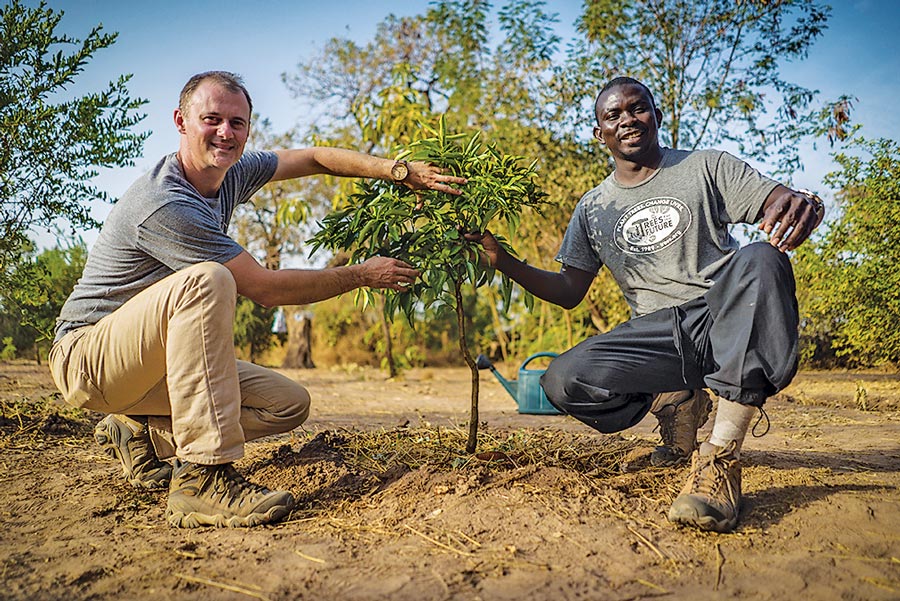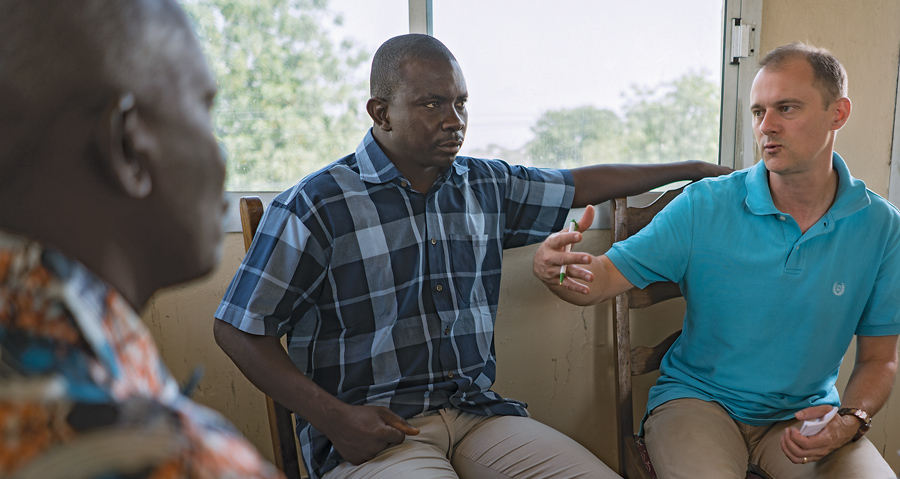The Color of Trees

The Color of Trees

As it turns out, seeing the forest for the trees was more important anyway.
Today, Leary is executive director of Trees for the Future, a nonprofit with a vision to change lives through regenerative agriculture and help farmers “plant themselves out of poverty.”
It’s an urgent mission, says Leary: “If you don’t know where your food is coming from, it’s probably causing harm to some family or community somewhere.”
When Leary was a Peace Corps volunteer in the early 2000s, the seeds of friendship took root with his homestay brother, a Senegalese farmer. The two began planting trees together. Little did they know that they were preparing the ground for a sweeping movement that would bring tens of thousands of farmers hope, health, and opportunities to create a sustainable future for themselves and their families.
Whether he’s talking about the extraordinary flavor of a carrot grown by a farmer down the road from his Maryland home, the transformation of a lifeless plot of land in sub-Saharan Africa, or the crushing injustice of the profits made by agribusiness at the expense of the health of the planet and everyone on it, Leary connects the choices to their consequences.
Planting trees is one part of a broad response to complex problems.
“You can’t just throw trees at this problem and make it better,” Leary says. Neither, he adds, can solutions be imposed on communities. A modern-day Johnny Appleseed, Leary and his U.S. team make up only a small percentage of a global organization that’s nearly 200 strong and has planted more than 220 million trees. Meaningful change begins with a conversation about farmers’ needs and the opportunities they see. Trees for the Future provides resources, including certification in agroforestry, and local staff members oversee projects implemented by the farmers themselves, strengthening agriculture and the food system within their own communities and molding each unique project to their cultural context.
Many of these projects involve creating “Forest Gardens,” which require composting, mulching, cover crops, water conservation, and integrated pest management. Trees for the Future’s comprehensive four-year training program, facilitated by local team members, empowers farmers to optimize their land by managing space, time, sun, shade, and water so they can grow enough produce to feed their families, provide fuel and fodder for livestock, and ultimately produce crops to sell. These programs have also made it possible for farmers to provide education for their children and have given new opportunities to young people whose only prospects once lay in dangerous voyages overseas to search for work.
As a rule, the organization makes sure that at least 30% of farmers enrolled in any program are women. This is an intentional benchmark, Leary says, because “history tells us we’ll have better outcomes if we prioritize women’s involvement and equip them to be mentors, trainers, and leaders.”

He majored in sociology & anthropology, with a concentration in environmental studies. When he wasn’t studying sustainability in the classroom, he was working on campus in some related endeavor. Leary found various ways to be involved, from deconstructing the old straw bale house and collecting recycling to “cleaning up after trees” as he assisted the grounds crew in the Scott Arboretum on the occasional Sunday morning — never guessing that leaf litter would be a critical component of breaking the cycle of hunger and poverty in sub-Saharan Africa.
The cautionary tale of Easter Island inspired Leary’s senior thesis on ecotourism. “They cut down all of their trees to build boats to search for faraway lands they never found,” he says. “The loss of tree cover led to soil erosion and the extinction of diverse species of fish, mammals, and birds, and the eventual collapse of the society.
“At Easter Island, we see in microcosm how quickly humans can degrade and deforest a landscape. At a time when billionaires are investing in interplanetary space travel, history tells us we should be building our natural resource base and protecting our food supply.”
Studying abroad in Zanzibar during his Swarthmore years whetted his appetite to see more of the world. After graduation, he arrived in Kaffrine, Senegal, as a Peace Corps agroforestry extension agent. Staying with the family of Omar Ndao, Leary began on-the-ground training in the Wolof language and culture. He also witnessed the ravages wrought by decades of growing monocultural cash crops such as peanuts.
Leary knew that trees could help restore the soil so farmers could grow diverse crops to feed their families, which would in turn restore the physical and economic health of these communities. He and Ndao worked together to establish the first Forest Gardens. They’re a data-driven solution to poverty, Leary says — severe food insecurity of 83% drops to 14% after one year in the program. Forest Garden farmers also harvest more diverse food all year round: “It’s about having more baskets, not more eggs in one basket.”
Ndao, who is now Trees for the Future’s plant-it-forward supervisor in Senegal, speaks with a kind of wonder about those years at the beginning of the project.
“We had no resources and we had to work very, very hard, traveling village to village by horse cart, and doing all the different steps to grow garab [trees] and plant them with farmers throughout the community to get things started,” Ndao says. When Leary returned to the United States and found a job with Trees for the Future, an organization first founded in 1989 by Dave Deppner, he continued this work with Ndao and others and extended this network of local community leaders.
In all, a dozen families across several communities planted about 5,000 trees in the first year Ndao and Leary labored together in Senegal. The hard work of that first generation of families growing Forest Gardens soon began to pay off. As their diverse crops grew, the idea began to spread.
“In Kaffrine, for example, there are many people in the community who wanted to work but didn’t know what path to take,” Ndao says. “The jardin-forêt [Forest Garden] is perfect for farmers because their mind and heart are together in the benefits and the system of the Forest Garden. They’re able to work in both the dry season and the rainy season.”
They’re also able to optimize the land they have instead of seeking more land or having to work as laborers on other people’s farms.
“Vegetable consumption has increased, people are healthier,” Ndao says, “and the knowledge farmers now have will enable them to farm the same land for the next 50 years.”


As the gardens mature, Leary and Ndao have continued to modify the model.
“In Senegal, we have a lot of different pests, like nematodes, termites, and locusts, that attack the crops,” Ndao says. And if farmers plant only one species of tree, they become susceptible to worms and other bugs attacking them. “Mixing different types of thorny, really hardy trees together in the green walls makes them resistant to all kinds of different pests,” Ndao says. “The system we have today is helping thousands of families to create very strong barriers around their fields that keep out not just goats but also sheep and cows. They’ve even proven strong enough to keep hippopotamuses out of the fields in Senegal.”
Diversity makes Forest Gardens, as well as the living fences surrounding them, stronger.
Trees for the Future Marketing and Communications Manager Lindsay Cobb sums it up well. “We’re committed to helping people understand the connections between reforestation and sustainable food systems,” Cobb says. “It’s not just about planting trees.”
It’s also, Leary says, about what’s on our plates. Saving the world from the cumulative effects of environmental degradation by food systems requires disruption.
“We need a great big reset in our food systems,” Leary says. “We need to align our preferences with what our local farmers can grow sustainably.”
Leary highlights the striking parallels between food insecurity in sub-Saharan Africa as a result of decades of growing monoculture crops with agrochemicals and what’s happening in the U.S. as the effects of agribusiness using the same practices become more and more evident. “When we lose biodiversity, we lose the ability to adapt,” he says. And preserving that precious biodiversity comes down to seeds.
Leary is also pleading with global influencers to lead by providing “good rigor,” examining food systems and the future of food. “We need to be able to grow food on this planet for a long time to come,” he says, “and right now the carbon footprint of most food is astronomical before the farmer even puts the seed into the ground.” None of this should come as a surprise, he adds: “Studying BSE [mad cow disease] in a microbiology course at Swarthmore in the late 1990s convinced me that harm comes from eating food grown in weird ways.”
In losing our connections to local, seasonal food, we’ve also lost connection to community, Leary says. “In Senegal, for example, there’s a beautiful, delicious, and sustainable food culture. If we were all eating locally, we’d be eating what our neighbors eat.”
Leary and his wife, who is from Senegal, and their two children, ages 9 and 12, regularly enjoy different cuisines including “a rainbow of vegetables” from the local community-supported agriculture program to which they belong. A CSA, Leary says, is an example of the kind of disruptive system that’s needed to bring about positive change.
Today, the boy who colored tree trunks green is leading a movement. As these trees, and knowledge, and the commitment to change practices that degrade the planet take root, there is hope. This year, the program will plant more than 50 million trees across nine countries.
“Through the pandemic, we didn’t experience a single interruption in our food supply,” Leary says. “Forest Garden farmers also had a whole grocery store of food available throughout the crisis. These closed local systems have so much to teach us about our own fragility when we depend on a global food system.”